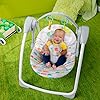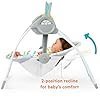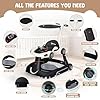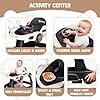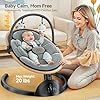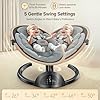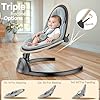Bright Starts Playful Paradise Portable Compact Automatic Baby Swing with Music, Unisex, Newborn +
9% Off6 in 1 Foldable Baby Walker, Activity Baby Walker-Baby Bouncer, Rocker, Activity Center,Push Walker,Detachable Trampoline Mat, Adjustable Speed Rear Wheels and Height,Music & Lights,Ages 6-18 Months
$129.95 (as of November 29, 2025 19:23 GMT +00:00 - More infoProduct prices and availability are accurate as of the date/time indicated and are subject to change. Any price and availability information displayed on [relevant Amazon Site(s), as applicable] at the time of purchase will apply to the purchase of this product.)Introduction
A feeder bottle is one of the most reliable baby feeding accessories that serve as an alternative to breastfeeding. Most new parents who cannot breastfeed their babies due to some reasons use baby feeder bottles.
Feeder bottles are of different types ranging from glass, and plastic to disposable baby bottles. The different feeder bottle types have varying prices. Depending on the amount of money you have, you can choose the kind that will match your baby’s requirements. In this article, we are going to discuss the three types of feeder bottles, their advantages and disadvantages, and the benefits of bottle feeding.
Parts of a Feeder Bottle
Generally, a feeder bottle consists of a few parts namely a teat (nipple), bottle, collar, and bottle cap. The teat is a rubber-like part that a baby puts in the mouth to suck milk in the bottle. Milk flows to a baby’s mouth through a small opening present in the teat.
The collar has a screw-like lining that tightens the teat against the bottle to prevent milk or formula spills. However, some special feeder bottles are vented. With that feature, your baby can suck milk from the container without breaks like in other bottles.
Types of Feeder Bottles
Depending on the material of the container, there are three kinds of baby bottles. Such feeder bottles include;
- Glass feeder bottles
- Plastic feeder bottles
- Disposable feeder bottles
Now, we are going to look at each of the feeder bottles in detail. Note that each type has its advantages and disadvantages.
Glass Feeder Bottles

Glass Feeder Bottles
- Glass baby feeder bottles are known for their durability and strength.
- They are made of glass material, which is resistant to scratches, cracks, and stains.
- Glass bottles are less likely to deteriorate over time compared to plastic bottles.
- They are free from harmful chemicals such as BPA (bisphenol A) and phthalates.
- Glass is a non-porous material, making it easier to clean and maintain hygiene.
- Glass bottles do not retain odors or flavors from previous feedings.
- They provide a safe and hygienic option for feeding your baby.
- Glass bottles are heat-resistant and can withstand high temperatures during sterilization.
- They can be safely used in a microwave or a bottle warmer.
- Glass bottles are eco-friendly and can be recycled.
- They offer a clear view of the contents, allowing you to monitor the amount of milk or formula consumed.
- Glass feeder bottles are compatible with most bottle accessories and nipples available in the market.
Pros of Glass Feeder Bottles
- No Chemicals: Unlike some plastic feeder bottles, glass bottles have no harmful chemicals that may put your baby’s health in danger.
- Thermo-Stable: Glass feeder bottles are highly stable at high temperatures. They can be sterilized in boiling water without any damage.
- Long-lasting: Compared to other feeder bottles, glass feeder bottles can be more durable when you take good care of them.
- Environmentally Friendly: Plastic bottles wear out quickly and are disposed of in the environment, therefore, causing pollution. Glass feeder bottles, however, are durable and there is no need to buy new ones and throw old ones frequently.
- No Stains: Glass feeder bottles do not stain easily like plastic feeder bottles. You will not spend a lot of time removing the remains of milk fat from the container.
Cons of Glass Feeder Bottles
- Highly Fragile: Glass feeder bottles are very fragile and can easily break into pieces when dropped on the floor.
- Heavy Weight: Glass feeder bottles are typically more substantial than their counterparts making it hard for babies to carry them for long.
- Costly: Generally, feeder bottles made of glass are more expensive than plastic feeder bottles.
Plastic Feeder Bottles

Plastic Feeder Bottles
- Plastic feeder bottles have been used for a long time.
- Concerns have been raised about the chemicals added to plastic bottles during manufacturing.
- Bisphenol A (BPA) is a chemical found in some plastic bottles that has raised health concerns.
- BPA has been associated with potential cancer risks in babies.
- Most modern plastic feeder bottles are now manufactured without BPA.
- Selecting BPA-free plastic bottles is important for ensuring the safety of your baby.
- BPA-free bottles undergo testing and adhere to safety standards.
- Manufacturers have responded to concerns by producing BPA-free plastic bottles.
- BPA-free plastic bottles provide a safe alternative for parents who prefer plastic bottles.
- It’s crucial to check labels or descriptions to ensure the plastic bottle is BPA-free.
- BPA-free plastic bottles are considered safe for use.
Pros of Plastic Feeder Bottles
- Lightweight: Plastic feeder bottles are generally lighter than glass bottles. Due to their lightweight, babies can hold them for a long without getting tired.
- Unbreakable: Unlike glass bottles, plastic feeder bottles cannot easily break when they fall on a hard floor.
- Strong: Plastic feeder bottles are sturdy. They are not fragile like glass feeder bottles.
- Affordable: Most parents can afford plastic feeder bottles because they are cheaper than glass bottles.
Cons of Plastic Feeder Bottles
- Wears Out Quickly: Plastic feeder bottles cannot last for long as glass bottles because they wear out quickly when washed and scrubbed regularly.
- May Have Harmful Chemicals: Plastic feeder bottles, especially the old ones, may have traces of harmful chemicals like BPA.
- Cannot Sterilize through Boiling: Plastic feeder bottles cannot be sterilized in hot boiling water like glass bottles.
Disposable Feeder Bottles

Disposable Feeder Bottles
- Convenient and hassle-free feeding on the go with EcoPure NurtureEase Disposable Feeder Bottles
- Biodegradable materials for a safe and eco-friendly feeding experience
- Pre-filled with all-natural baby formula for high-quality nutrition
- Ergonomic design for easy and comfortable handling
- Spill-proof cap to prevent wastage of formula
- Anti-colic vents for reduced discomfort and fussiness during feeding
- Perfect for travel, outings, and home use
- Grab, twist, and feed with confidence and ease
The disposable feeder bottles are plastic but have a sterilized liner that can be replaced during each feeding.
Pros of Disposable Feeder Bottles
- No Chemicals: Modern disposable feeder bottles are free of chemicals such as BPA. They are safe for your baby’s health because the FDA approves them.
- Can Be Cleaned Easily: Unlike plastic feeder bottles, cleaning disposable feeder bottles is entirely more comfortable.
- Lightweight: Disposable feeder bottles are lighter than glass feeder bottles, and you can carry them easily in your baby’s pack bag.
Cons of Disposable Feeder Bottles
- Very Expensive: Disposable feeder bottles are more costly than other types of feeder bottles. The replaceable liners are also expensive.
- Not Environment-Friendly: The disposable liners may pose a danger to the environment without proper disposal
- Regular Purchase of Liners: The disposable feeder bottles require a frequent purchase of replaceable liners.
Five Benefits of Bottle Feeding
- Good for Feeding in Public
Most mothers find it difficult to breastfeed their babies in public. To minimize public embarrassment, most women bottle-feed their babies.
- Less Feeding Times
Bottle feeding requires fewer feeding times. With formula, you can feed your baby after every three to four hours. With breastfeeding, you may have to feed the baby after every two to three hours.
- Accurate Feeding
Through bottle feeding, you can estimate the amount of milk or formula that your baby consumes. With breastfeeding, it is not easy to know the volume of milk your baby would have consumed at the end of the day.
- Reduced Breast Pain
Breastfeeding may come along with pain resulting from cracked nipples and baby bites. But with bottle feeding, a mother does not have to suffer from such pains.
- You can Get Help From Family Members
With bottle feeding, you don’t have to do it alone. Instead, you can ask your family members or husband to assist you in feeding the baby.
Final Word
Feeder bottles are essential for new parents who cannot breastfeed their babies due to some reasons. They come in different types, including glass, plastic, and disposable, each with its advantages and disadvantages. Glass bottles are durable, environmentally friendly, and do not contain harmful chemicals. However, they are fragile, heavy, and costly. Plastic bottles are lightweight, unbreakable, strong, and affordable, but they wear out quickly and may have harmful chemicals. Disposable bottles are convenient but may not be cost-effective. Ultimately, the type of feeder bottle chosen will depend on the parent’s budget, lifestyle, and baby’s requirements.
FAQs
What are the parts of a feeder bottle?
The parts of a feeder bottle include a teat (nipple), bottle, collar, and bottle cap.
What are the advantages of glass feeder bottles?
Some advantages of glass feeder bottles are that they do not contain harmful chemicals, are thermally stable, durable, environmentally friendly, and do not stain easily.
“Feeding a baby is not an interruption of work, but the most important work.” – Unknown.
Related Links:
- https://en.wikipedia.org/wiki/Haberman_Feeder /By Wikipedia
- https://en.wikipedia.org/wiki/Baby_bottle /By Wikipedia
- https://www.wikihow.com/Bottle-Feed-a-Newborn /By Wikihow
- https://www.wikihow.com/Bottle-Feed-Calves /By Wikihow

Hi there!
My name is Sabrina. As a devoted mother of four children, I have personally experienced the benefits and effectiveness of various types of baby swings. As the founder of babyswingclub.com, I have dedicated myself to providing valuable information and insights into the world of baby swings.
My thorough research and hands-on experience allow me to offer valuable insights into the features, safety standards, and overall performance of different baby swings.



